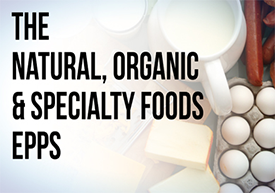Event Insights: Natural, Organic & Specialty Foods 10/3/2015
In most of the Grocery-related (and even some of the HBC) event insights pieces we’re been running throughout the year, natural and organic were the top trends. So I was looking forward to seeing what the trends were at our show that focused primarily on natural and organic products.
Based on our Event Debriefings – one on one interviews between ECRM staff and attendees of our Natural, Organic & Specialty Foods event – several key trends were top-of-mind among buyers and sellers, including convenience, free-from products, and proteins. Among specialty items, local, artisanal and single-serve items are trending among consumers, according to attendees, but as there is a huge crossover among specialty and natural/organic items, the trends below apply to both.
Healthy Convenience
There is an increased demand for natural and organic products that are easy to prepare or are portable grab-and-go items. This is also true with snacks. We’ve seen many retailers such as Target and Wegmans this year announce that they will be emphasizing healthier items like granola and nuts in their promotions and de-emphasizing salty and sugary snacks, and the discussions between suppliers and buyers at the event reflect this trend. Snack products for kids that incorporate fruits and vegetables are also gaining in popularity. Traditional snacks like cookies and chips are incorporating healthier items, as well.
Not surprisingly, with more of these natural and organic grab-and-go items available, they are increasingly making their way onto convenience store shelves, particularly products such as health bars, fruit inside squeeze pouches, and natural and organic meat snacks, though some suppliers of these products say they still struggle to get on the c-store shelves.
Proteins
Whether it is the Paleo, Atkins, Slow-Carb, or another diet that is driving it, high-protein items are increasingly popular with the health-minded consumers, and this is being reflected in new product offerings, which also include a greater number of products with plant-based proteins for vegan diets. Even products not typically thought of as high-protein sources – like pasta – are now including ingredients (like beans) to boost their protein content to better attract these shoppers.
Ancient grains are also gaining in popularity for their high-protein content as well as the many vitamins and minerals found in them. While quinoa-based products seem to be getting a lot of buzz lately, other ancient grains such as buckwheat, millet and spelt are also popular, particularly as most of them are also gluten-free.
'Free-From' Foods
Gluten-free, and other “free-from” items such as sugar-free, fat-free, and non-GMO are also in greater demand, according to attendees interviewed at the event. Indeed, the terms “clean labels” and “transparency” were often mentioned by buyers and sellers alike, as consumers are looking for products with both fewer ingredients and ingredients that they understand.
While food allergies and other ailments drive much of this demand, what is particularly interesting about these items – particularly gluten-free – is that they are perceived as generally healthier than their non-"free from" counterparts. Many consumers without celiac disease have incorporated gluten-free products into their diets for this reason, and it has driven sales and product proliferation almost to the point when some retailers are concerned it’s reaching a saturation point. However, one channel where gluten-free items have yet to penetrate deeply, according to one supplier, is the dollar channel.
Challenges:
Buyers and sellers noted several challenges within the Natural, Organic and Specialty Foods categories. Among them are:
- The increased saturation of Gluten free products: There is a need for increased differentiation to help consumers determine which products will meet their needs.
- Space restrictions in the stores make it tough to get new items on the shelf
- For buyers, keeping up with all of the innovations. (Sellers can address this by sending new product information to ECRM for posting on the Content Gateway!)
- Understanding the distributor role in the natural, organic and specialty foods industry, and how to keep costs down when working with distributors.
Related Links:
The 5 P’s of a Successful Buyer-Seller Partnership – a four part series by Raley’s Director of Wellness & Sustainability Megan Burritt.
Presentation Download: SPINS Industry Overview
Presentation: Growing Center Store Sales With Natural & Organic
Expert Column: The Organic/Gourmet Conundrum
Register for next year’s Natural, Organic & Specialty Food Events:
Natural, Organic & Specialty Foods: August 22 to 25, 2016, at Sheraton San Diego Hotel & Marina (San Diego, CA)Foodservice Natural, Organic & Better For You: November 7 to 9, 2016, at Westin Cape Coral Resort at Marina Village (Cape Coral, FL)

